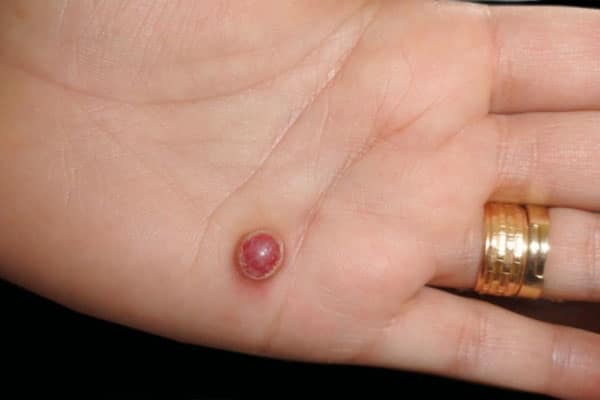What are the symptoms of pyogenic granuloma?
Pyogenic granuloma is a benign, rapidly growing vascular lesion that commonly appears on the skin or mucous membranes. Symptoms include:
- Red or Purple Nodules: The lesion typically presents as a small, red or purple bump. It is often described as having a “glassy” or “shiny” appearance due to its vascular nature.
- Rapid Growth: The nodule can grow quickly over weeks to months, reaching sizes of up to a few centimeters.
- Bleeding or Ulceration: Pyogenic granulomas are prone to bleeding easily, especially if the lesion is traumatized. The surface of the nodule may become ulcerated or weep blood.
- Pain or Tenderness: The lesion can be painful or tender, particularly if it is located in an area subject to frequent irritation or trauma.
- Pedunculated Appearance: Many pyogenic granulomas are attached to the skin by a stalk or peduncle, making them appear as though they are “hanging” from the surface.
- Location: Common sites include the hands, face, and oral mucosa, but they can appear anywhere on the body.
Pyogenic granulomas are typically benign and can be managed effectively with treatment, which may include surgical removal, cryotherapy, or laser therapy, depending on the size and location of the lesion.
What are the causes of pyogenic granuloma?
Pyogenic granuloma, also known as lobular capillary hemangioma, is a benign vascular tumor with several potential causes or contributing factors:
- Trauma or Injury: Physical trauma or minor injuries to the skin can trigger the development of pyogenic granulomas. This is particularly common in areas prone to frequent friction or minor trauma.
- Hormonal Changes: Pyogenic granulomas are sometimes associated with hormonal changes, such as those occurring during pregnancy. They are also seen in conditions like puberty or with the use of oral contraceptives.
- Certain Medications: Some medications, especially those that can affect blood vessels or induce hormonal changes, have been linked to the development of pyogenic granulomas.
- Chronic Irritation: Prolonged irritation or chronic inflammation of the skin, such as from dental appliances or ill-fitting clothing, can contribute to the formation of these lesions.
- Genetic Factors: Although less common, there may be a genetic predisposition or familial tendency for developing pyogenic granulomas.
- Underlying Health Conditions: Rarely, pyogenic granulomas can appear in association with certain systemic conditions or syndromes, though this is not well understood.
In many cases, the exact cause of a pyogenic granuloma may not be identifiable, and the lesion may develop spontaneously without a clear trigger.
What is the treatment for pyogenic granuloma?
The treatment for pyogenic granuloma generally involves removing the lesion, as it can be persistent and prone to bleeding. The treatment options include:
- Surgical Excision: Complete surgical removal of the pyogenic granuloma is a common and effective method. This usually involves cutting out the lesion along with a small margin of surrounding tissue to reduce the risk of recurrence.
- Laser Therapy: Laser treatment can be used to target and destroy the blood vessels within the pyogenic granuloma. This method is less invasive than surgery and is often used for smaller lesions or those located in sensitive areas.
- Cryotherapy: This involves freezing the lesion with liquid nitrogen. Cryotherapy can be effective but may require multiple sessions and can sometimes leave a scar.
- Electrosurgery: This technique uses electrical currents to burn off the lesion. It is generally used for smaller lesions and can be effective in preventing bleeding.
- Topical Treatments: In some cases, topical treatments with certain medications or agents may be used, though this approach is less common and may not be as effective for larger or more persistent lesions.
- Chemical Cauterization: Application of chemical agents such as silver nitrate can help to dry out and destroy the lesion, though this is less commonly used compared to other methods.
- Observation: For very small or asymptomatic pyogenic granulomas, especially those that are not bothersome or do not cause significant problems, a “watch and wait” approach may be considered. However, this is less common due to the tendency of these lesions to bleed and their potential to cause discomfort.
Treatment choice often depends on the lesion’s size, location, and recurrence risk. Follow-up care is important to monitor for any signs of recurrence or complications.

Leave a Reply
You must be logged in to post a comment.